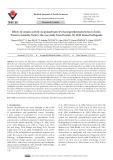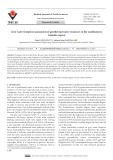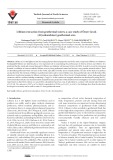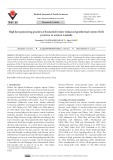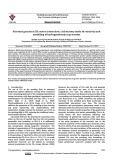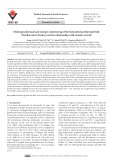
Geothermal water
-
In this study seasonal changes in the geochemical and stable isotope compositions of Hisaralan thermal waters in Simav Graben, western Turkey, were investigated with regards to a variety of mineral-water interactions and mixing processes. The Hisaralan and Emendere geothermal waters, with temperatures of up to 99 °C, were mostly of Na-HCO3 and Ca-HCO3 types. The δ18O and δ2 H values of the Hisaralan waters ranged from –9.32‰ to –8.73‰ and –65.02‰ to –61.10‰, with maximum seasonal differences of 0.3‰ and 1.8‰. The Emendere waters were represented by a more positive range of δ2 H values (–54.
 22p
22p  tanmocphong
tanmocphong
 29-01-2022
29-01-2022
 13
13
 1
1
 Download
Download
-
Before this earthquake, water resources were monitored in the areas of Bayraklı, Gülbahçe, and Seferihisar. For this purpose, 10 groundwater monitoring wells were drilled in the Bayraklı area, where groundwater level, temperature, and electrical conductivity changes were monitored at 1-h intervals in 5 wells. Besides physical parameters such as groundwater levels, temperatures and electrical conductivities, hydrogeochemical cations, and anions measured in the study area. Change in the groundwater levels was observed before, during, and after the Samos earthquake.
 21p
21p  tanmocphong
tanmocphong
 29-01-2022
29-01-2022
 17
17
 1
1
 Download
Download
-
This paper aimed to determine the grey water footprint (GWF) of geothermal water resources and to investigate the effect of biochar adsorption on grey water footprint in Southeastern Turkey. In this paper, GWF has been calculated in terms of iron (Fe), arsenic (As), manganese (Mn), boron (B), and chrome (Cr) concentrations for fifteen observation geothermal resources located in Southeastern Anatolia Region. In this study, a new approach based on the GWF was developed in order to determine the geothermal water pollution.
 8p
8p  tanmocphong
tanmocphong
 29-01-2022
29-01-2022
 19
19
 2
2
 Download
Download
-
Lithium (Li) is the lightest metal, has unique physicochemical properties and is the main component of lithium-ion batteries. Rechargeable lithium-ion batteries play a very important role in maximizing the performance of electric devices and vehicles. It is predicted that the metal and mineral demand for lithium-ion batteries will increase 56 times by 2050. In order to meet the increasing demand, in addition to known methods, lithium recovery from geothermal waters has become a very popular research subject.
 13p
13p  tanmocphong
tanmocphong
 29-01-2022
29-01-2022
 24
24
 2
2
 Download
Download
-
Although the western Anatolian region is a foci for hydrothermal systems, this region has several high heat-generating granitic intrusive bodies that qualify to be candidates for enhanced geothermal systems (EGS). Considering the future energy requirement, carbon dioxide emissions reduction strategies, food, and water security issues, these granites appear to be the future clean energy source for the country. One such granite intrusive is located in the Kestanbol area in the western Anatolian region.
 13p
13p  tanmocphong
tanmocphong
 29-01-2022
29-01-2022
 19
19
 1
1
 Download
Download
-
Batch-type laboratory reactivity experiments and mo delling of hydrogeochemical interactions of a granite-scCO2-water system were conducted at 100 °C and 10 MPa in order to evaluate the geochemical and mineralogical responses of the granite to long-term reaction. The laboratory reactivity tests were conducted for a to t l duration of 70 days, and the continued hydrogeochemical interactions for up to 210 days we re determined by geochemical simulations.
 16p
16p  tanmocphong
tanmocphong
 29-01-2022
29-01-2022
 13
13
 1
1
 Download
Download
-
Kestanbol geothermal field is located in northwestern Turkey and is one of the highest temperature geothermal fields in the Biga Peninsula. In this study, one geothermal well, two geothermal springs, and two cold springs were monitored for one year in Kestanbol geothermal field to determine hydrogeochemical and isotopic characteristics. Additionally, any possible relationship between seismic activity and variations in the hydrochemistry of geothermal water was investigated.
 22p
22p  tanmocphong
tanmocphong
 29-01-2022
29-01-2022
 16
16
 1
1
 Download
Download
-
To improve the utilization rate of hot dry rock resources, it is necessary to recover the energy of geothermal tailwater and improve the net output work. An improved ammonia-water power cycle is proposed based on the Kalina cycle. Taking the geothermal parameters of the Husavik Power Plant in Iceland as the prototype (the water temperature of the geothermal well is 122°C, and the tailwater temperature is 80°C), the numerical simulation of the modified Kalina cycle is carried out by using Engineering Equation Solver software.
 11p
11p  tanmocphong
tanmocphong
 29-01-2022
29-01-2022
 17
17
 1
1
 Download
Download
-
Balçova-Narlıdere Geothermal Field (BNGF) hosts the largest geothermal district heating system of Turkey and several geothermal wells used for district heating and thermal tourism activities. This study assesses the use of BNGF geothermal fluid for agricultural activities. The spent geothermal brine was treated using nanofiltration and reverse osmosis membranes on a pilot-scale membrane test system. The qualities of the product were evaluated in terms of agricultural irrigation integrated with the implemented innovative wireless sensor network.
 14p
14p  tanmocphong
tanmocphong
 29-01-2022
29-01-2022
 12
12
 1
1
 Download
Download
CHỦ ĐỀ BẠN MUỐN TÌM









